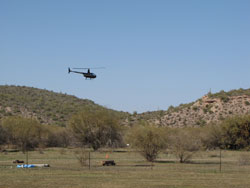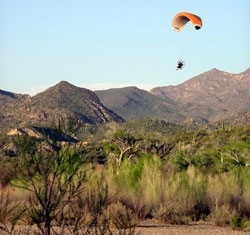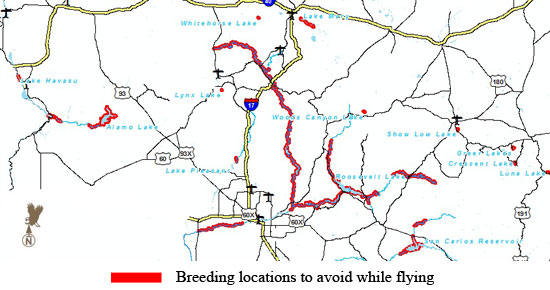Loading Search
Southwestern Bald Eagle Management Committee
Guiding Bald Eagle Management in Arizona

 Low flying (<2,000 feet above ground level, or AGL) planes, helicopters, and other aircraft like motorized parachutes are common human activities in some bald eagle breeding areas in Arizona. Although low-flying aircraft currently account for about 10% of all human activity at these areas, they elicit almost 25% of the bald eagle’s significant responses during a breeding season (vocalizing, restlessness, flushing from the nest or a perch, or leaving the area) (Tables 1 and 2).
The most important laws related to Arizona’s eagles are Arizona Revised Statutes Title 17, the Bald and Golden Eagle Protection Act (Eagle Act), the Migratory Bird Treaty Act, the Airborne Hunting Act, and the Lacey Act. The Eagle Act in particular contains special protections for eagles, and includes a definition of disturbance which means “to agitate or bother a bald or golden eagle to a degree that causes, or is likely to cause, based on the best scientific information available, 1) injury to an eagle, 2) a decrease in its productivity, by substantially interfering with normal breeding, feeding, or sheltering behavior, or 3) nest abandonment, by substantially interfering with normal breeding, feeding, or sheltering behavior."
Low flying (<2,000 feet above ground level, or AGL) planes, helicopters, and other aircraft like motorized parachutes are common human activities in some bald eagle breeding areas in Arizona. Although low-flying aircraft currently account for about 10% of all human activity at these areas, they elicit almost 25% of the bald eagle’s significant responses during a breeding season (vocalizing, restlessness, flushing from the nest or a perch, or leaving the area) (Tables 1 and 2).
The most important laws related to Arizona’s eagles are Arizona Revised Statutes Title 17, the Bald and Golden Eagle Protection Act (Eagle Act), the Migratory Bird Treaty Act, the Airborne Hunting Act, and the Lacey Act. The Eagle Act in particular contains special protections for eagles, and includes a definition of disturbance which means “to agitate or bother a bald or golden eagle to a degree that causes, or is likely to cause, based on the best scientific information available, 1) injury to an eagle, 2) a decrease in its productivity, by substantially interfering with normal breeding, feeding, or sheltering behavior, or 3) nest abandonment, by substantially interfering with normal breeding, feeding, or sheltering behavior." 
